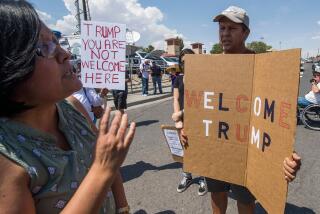Prejudice Is a Choice; so Is Change
- Share via
The 2000 census revealed what many of us have suspected, that there is no longer a majority group in California. Although this puts us at the cutting edge of multiculturalism, still all of us tend to view interactions from our own cultural viewpoint and many of us carry prejudices that have been passed on from generation to generation. We can learn to live and work together harmoniously, or we can divide along racial / cultural lines and engage in cultural wars. The choice is ours.
While prejudice and discrimination seem to have always been with us, it has only been since the 1920s that both have come to be seen as problems. Before that, even social scientists had tended to view prejudice and discrimination as essentially natural.
The current thinking by social psychologists is that prejudice emerges at ages 4 to 7. Humans seem to have a predisposition to be prejudiced. Too, there seems to be an unreasonableness about it. Prejudiced individuals typically resist changing their beliefs, even in the face of contradictory information.
*
To understand the causes of prejudice from an individualistic or psychological viewpoint, we must recognize certain universal psychological processes. These processes build in a human propensity for prejudice. One such process is called “projection.” Projection occurs when we defend against unacceptable feelings by “putting” them into someone else. Projection oftentimes occurs unconsciously, which may explain why prejudice is so irrational and difficult to change.
Social scientists believe that the authoritarian personality type is more likely to develop strong prejudices than others. These are people who cannot own up to negative aspects of themselves, and tend to be raised by parents who are harsh and threatening and whose discipline is arbitrary. Roles are clearly defined in terms of dominance and submission. This type of discipline leaves them feeling inferior and charged with hostility. Many psychologists believe the feelings of inferiority are projected onto others and, because the anger cannot be directed toward the parents, the child grows into an adult who lashes out at the world.
On the other hand, the more a person is accepting of all aspects of the self, both the positive and the negative, the less need to blame and look for scapegoats. At least nine studies have found that nonprejudiced people are high in self-acceptance, while prejudiced individuals suffer from low self-acceptance. Counseling and other efforts designed to increase self-acceptance resulted in decrease of prejudiced attitudes.
Another psychological theory involves “splitting and displacement.” In splitting we divide people into “all good” and “all bad.” When we feel anger toward someone who is “good,” we displace the bad feelings onto someone who is weaker or less threatening as a way to avoid damaging a person upon whom we depend. The classic example is the employee who is reprimanded at work, comes home and yells at the spouse, who in turn scolds the children, who kick the family dog.
We can also displace bad feelings onto a group. For example, Detroit blamed the Japanese for selling cars to Americans, rather than attempting to understand why Americans were buying Japanese cars. In some ways, splitting and displacement make life seem simpler.
Although these psychological processes build in a potential for prejudice, individual differences, along with an interplay of cultural norms and social pressures, determine a person’s susceptibility to prejudice. Prejudice does not automatically lead to discrimination. Self-interest and other factors can override biased behavior.
*
What about solutions?
First we must acknowledge that prejudice and discrimination exist. Often they are perpetuated by a conspiracy of silence. We’re ready to recognize prejudice in others but not within ourselves. It takes a critical mass, perhaps only 10% of a group or organization, to make change happen in that organization. And when organizations and social groups begin to change, society changes.
If you think it can’t happen, think about the civil rights movement that began 40 years ago. That movement was sparked by one woman who refused to move to the back of the bus. A few college and high school students followed; before long the few had turned into many and our country was changed forever.
We are all in a position to either help perpetuate the status quo, or provide impetus for change. What choices will you make?
More to Read
Sign up for Essential California
The most important California stories and recommendations in your inbox every morning.
You may occasionally receive promotional content from the Los Angeles Times.













